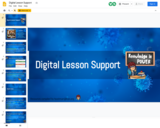
English Instructional Plan – Descriptive Writing for Grades K and 1
- Subject:
- English
- Writing
- Material Type:
- Lesson Plan
- Author:
- VDOE Project Team
- Date Added:
- 04/22/2022

English Instructional Plan – Descriptive Writing for Grades K and 1

This lesson helps students realize the impact of writing with effective description.

This video is part of the Continue to Know with WHRO TV series. Watch Claire Verdillo teach about determining relevant information.

English Instructional Plan – Determining Validity of Sources 6-8

English Instructional Plan-Developing Fluency 6-8

English Instructional Plan-Developing Objective Summaries 6

English Instructional Plan Developing Thesis Statements 6-8

Students will use a Children's Dictionary to answer questions and search for meanings of unfamiliar words.

This video is part of the Continue to Know with WHRO TV series. Watch Beth Eanes teach about four different organizational patterns in text structures.

English Instructional Plan-Differentiate Between Formal and Informal Language

Theresa Sincere-Eastman of Loudoun created this presentation for teachers moving to online teaching. It has several tips and links to supportive resources.

Teachers will need to make a copy of the digital activity prior to using it.Students will complete a slide that will describe them and show a photo.

This is a quick, mini-lesson about direct quotes and paraphrasing. The Google Slide presentation is available to preview: Mini-Lesson: Direct Quote vs ParaphraseTo get an editable copy, click this link: Copy of Mini-Lesson: Direct Quote vs Paraphrase

English Instructional Plan Direct and Indirect Characterization 6-8

TSW be working collaboratively on a summative assessment but will be measured in two areas: content and collaboration. As our world continues to be interconnected, we need to be able to balance workload, expectations, and keep proper documentation on projects. Students will be graded on meeting the content requirements, here a one pager/presentation/tri fold about the novel read in class, as well as on their ability to collaborate and keep track of their successes and failures with documentation. Students should have a basic understanding of the novel in question, figurative language, plot summary, character traits, irony, and conflict to finish the one pager/content portion of the assignment. Ideally this lesson will take place in the third/fourth quarter of the school year.

Students will be asked to make predictions and retell a story in sequential order by drawing pictures and writing sentences to go with the pictures. Students will be paired and take turns drawing a picture following an algorithm (step by step directions) their partner gives.

Using the mentor text How to Code a Sandcastle, students will display their sequence knowledge and coding skills to guide teammates through the correct order of how to build an ice cream sundae. Just like in computer science, when scientists need to construct programs and sequential events, students will use sequence structured graphic organizers, cut and paste picture prompts, as well as blank coding mat templates to help complete this fun and engaging lesson encompassing both Language Art and Computer Science standards.

English Instructional Plan –Drawing conclusions and making inferences: Crime scene analysis

Novel groups and Dystopian reading Unit

Novel groups and Dystopian reading Unit